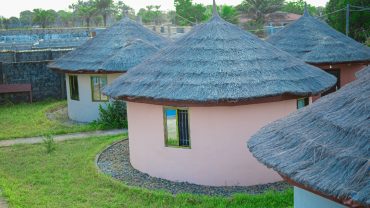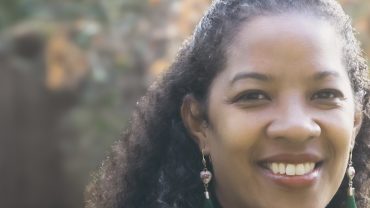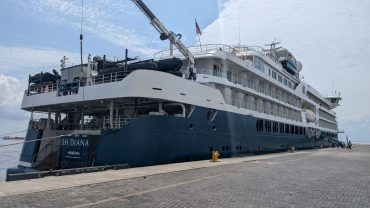Sierra Leone’s chattering classes are up in arms. The focus of their online fury? Government plans to locate a fishing harbour at Black Johnson Beach. No matter that few of us could find it on a map and fewer still have been there, the issue has united disparate voices like little before it.
Located in the centre of the Western Peninsula, an unspoiled beach backed by forest, Black Johnson seems an unlikely choice for a fishing harbour. Despite that, rumours have abounded for two or more years that something was in the offing. Such are the mysteries of government machinations that even those with close links to the area were unsure as to what exactly.
Matters came to a head when some property owners learned from the Ministry of Lands that plans were afoot to compulsory purchase their holdings. Combine that with sightings of Chinese individuals in the area and the rumour-mill went into overdrive. It was to be a fish meal plant, similar to one that has destroyed its adjacent environment in The Gambia. It was connected to mining for Platinum in the hills behind the beach. It was mining related, but for Coltan. As one group of landowners admitted to having been in discussion with government for several years, another quickly went to press issuing a series of releases.
The result was immediate and unexpected. A combination of social media savvy, a protected rainforest, endangered species, a postcard perfect beach and soon to be disenfranchised community almost guaranteed international attention, without the bogeymen of opaque Chinese investment and a fishing industry already decimated by foreign fleets. A media storm quickly whipped up, with opinion (both informed and otherwise) on Twitter and Facebook soon joined by international contributions.
Sierra Leone’s government, unused to accountability, found itself on the back foot, our Fisheries Minister hurrying out a statement that left more questions than it answered. The government, she said, had long yearned for a fishing harbour. Not, note, a fish meal plant, albeit the planned harbour would have a recycling facility attached. Fortuitously our Chinese development partners had made available $55 million by way of a grant. Studies had indicated that Black Johnson was the best location and the Ministry of Lands had secured 252 acres there. The Ministry of Finance, meanwhile, had set aside Le13.76 billion to compensate landowners. The completed plant would help provide food security, create jobs and train Sierra Leoneans in boat maintenance and repair, something Freetown’s 200+ year old port has so far failed to do. The government, she told us, was people orientated and would do nothing inimical to the interests of the people.
Had she hoped that this note would put paid to the matter she could not have been more wrong. As well as the concerned landowners, Sierra Leone’s (previously sleeping) media and environmental bodies got in on the act. Had an environmental impact assessment been conducted? Why did the harbour need 252 acres when Freetown Port is a mere 80 or so? How had the Ministry of Lands ‘secured’ this acreage without consulting the landowners? Was $525 per town lot fair compensation? What was the essence of the ‘recycling’ plant? How had studies shown Black Johnson to be the ideal location when previous World Bank reports had specifically recommended against the area? Where was the quoted study?
Media scrutiny and public interest increased, joined by legal and environmental NGOs. The Institute for Legal Research and Advocacy for Justice (ILRAJ) and legal empowerment advocates Namati jointly dashed off letters; to the Fisheries Minister, asking some of the questions above, and to the Environmental Protection Agency (EPA), asking if any Environmental Impact Assessment licence application had been applied for. The response from the Fisheries Ministry? Yaing! Which, oddly enough, was the essence of the written response from the EPA.
Government wasn’t ready to roll over yet. Friendly media were briefed to put their side of the story. The Chinese Embassy stepped forward to say that they were not owners of the project but merely facilitating the nation to achieve its dream, slapping the wrists of sceptics in the process. Somehow someone managed to locate the (hitherto missing in action) Environment Minister and his Cabinet colleague the Minister of Water Resources. Together with the Fisheries Minister they visited the site (reports have it that they did not in fact know the exact location) to rebuff the misinformation in the public domain and chastise enemies of development. Notably, the Minister of Tourism was absent. Odd, given that Black Johnson sits at the middle of the Western Peninsula, often referred to as the ‘Jewel’ in Sierra Leone’s touristic crown, and upon which she has stated she wishes to develop the nation’s tourist potential. Even odder when one considers that the government of Sierra Leone has identified tourism as one of the four pillars upon which they wish to build the nation’s economic future. Approached for her views on the project, her response has been ‘no comment’. Mind you her silence might be wise. The head of the EPA, when called upon in a radio interview to expand on the absence of an environmental impact assessment licence, contradicted the letter from his own agency and suggested that an application had indeed been received but had ‘fallen of the system’, an excuse so ridiculous that even his interviewer and fellow guest appeared to sense his embarrassment and declined to pursue the matter too aggressively.
So here we are, two weeks on, arguably none the wiser. The good news is that, despite some statements that might indicate otherwise, it does not seem that the Black Johnson project is a done deal. It may yet be, and that may even be a good thing for the country but, before then, key questions need to be answered:
- What is government’s rationale for a fishing harbour?
- What are the terms of China’s grant to Sierra Leone?
- What is the nature of the recycling facility?
- How was Black Johnson chosen as the most suitable location?
- What other locations were considered?
- Where is the bathymetric report supporting the decision?
- What has changed between the previous World Bank studies and now?
- Has an environmental impact assessment licence been applied for?
- Why does the project require 252 acres?
- Who was consulted?
- What does the proposed fishing harbour mean for Sierra Leone’s touristic ambitions?
Let’s not even think about the mining activity that has already started in the forest above Black Johnson beach, with the access road clearly visible.




Comment (0)